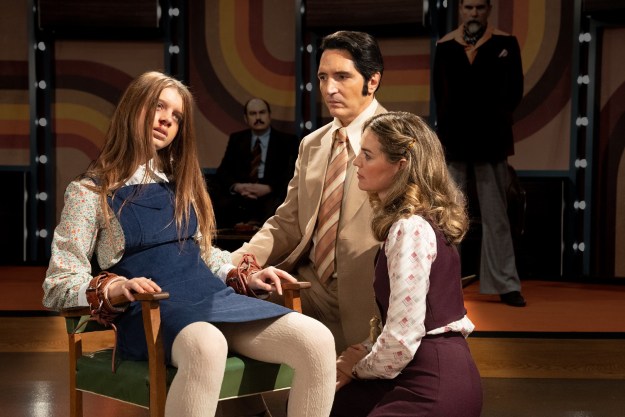
“The movie gets by on the fun of its flashback pantomime.”
- Fun talk-show backdrop
- Nifty practical effects
- Great leading role for David Dastmalchian
- Not always convincing
- Not very scary
- Weak payoff
Anything can happen on live TV. That old axiom still holds true today — just ask Chris Rock. But it was perhaps especially true in the 1970s, when America stayed glued to The First Television War, when a Florida news anchor ended her life on the air, and when the Johnny Carsons of the world more regularly broadcast live from their cozy studio sets, goosing viewership with the implied instruction to expect the unexpected. Late Night with the Devil, an amusing if never entirely convincing (or especially terrifying) exercise in found-footage spookiness, winds back to that bygone era of high-wire showmanship to imagine a dark realization of live TV’s promise: What if the rolling cameras of a late-’70s midnight talk show beamed something truly shocking into households?
The filmmakers, Aussie siblings Cameron and Colin Cairnes, are plain aficionados of TV Land kitsch, their own country’s and the American kind. They’re hooked on the blithe, cheeky sensationalism of ’70s late night — how nocturnal emcees welcomed a world of weird into their regularly scheduled programming, becoming circus ringleaders without sacrificing their careful showbiz poise. Late Night with the Devil taps into the anything-goes hucksterism of that age and then weds it to a more sinister strain of contemporaneous culture. The intended impression is of a nightly network staple haunted by the ghosts of Charles Manson, the Amityville murders, and The Exorcist.
The movie’s gimmick is that it presents itself as an uncensored re-airing of a nightmarish TV event: the chilling final episode of a fictional ’70s talk show called Night Owls. The host, Jack Delroy (David Dastmalchian, the lanky, eccentric character actor who’s logged time in the trenches of Marvel, DC, and Dune), is a Midwest go-getter haunted by both the recent loss of his wife to cancer and by the losing war for eyeballs he’s waged against Carson. We learn all of this through a faux-documentary introductory montage. The main attraction is the full program he lines up to save his critically acclaimed, ratings-challenged show — a sweeps-week Halloween special that pits several paranormal experts against each other and which plays out for us in near real-time, complete with black-and-white, behind-the-scenes interludes during the cuts to commercials.
For a while, the movie gets by on the fun of its flashback pantomime — how it invokes the spirit of what it’s imitating, a ’70s variety showcase of bandleader banter, lively interviews, and Nielsen-friendly stunts. Delroy’s panel includes a charlatan medium (Fayssal Bazzi), working the live studio audience with his parlor tricks before possibly tapping into real spiritual danger; a parapsychologist (Laura Gordon) who appears with the subject of her book, a supposedly possessed teen (Ingrid Torelli) with serious Regan MacNeil vibes; and, most entertainingly, a former magician (Ian Bliss) who’s given up his lucrative racket for the perhaps even-more-lucrative business of debunking supernatural hokum. About the best compliment you could pay the film is that it successfully apes insomniac trash TV; even without the inevitable demonic intrusions, the clash of personalities would make for good nightcap viewing.

Often, Late Night with the Devil resembles nothing so much as one of the mock-doc segments from the ongoing V/H/S series, extended with some success to feature length. As far as aesthetics go, it’s much more convincing when mimicking the look, feel, and videotape texture of ’70s post-primetime than when passing itself off as a documentary about the events. Nitpickers might get hung up on stray inconsistencies of production design, makeup, or performance; the illusion of something genuinely plucked from the airwaves of the Me Decade wavers. It doesn’t help that the Cairnes brothers eventually break format, as if uncertain how to deliver the psychodramatic crescendo without pushing past the limitations of their doomed talk-show conceit.
As in some of the best found footage thrillers, from The Blair Witch Project to the first Paranormal Activity, the horror springs from the foolishness of trifling with dark forces from behind a camera. Delroy, performing his seemingly harmless, seasonally appropriate version of it-bleeds-it-leads entertainment, has made like Guy Woodhouse of Rosemary’s Baby and forged a rather literal pact with the showbiz underworld gods. Of course, the fame he’ll achieve is very much of the monkey’s paw variety. In so much as Late Night with the Devil works as a cautionary tale of careerism at any cost, Dastmalchian is the reason. The blockbuster bit-player shows us the sweaty desperation and mounting dread beneath his showman sincerity in perhaps his meatiest role ever. His portrait of a Carson wannabe coming undone is the most persuasive thing about the movie, its realest touch.

Still, the ending is a letdown. Late Night with the Devil builds and builds, promising the inevitable moment when all of Delroy’s boob-tube cheese — his jokey communions and myth-busting debate — will explode into real danger. That’s the whole hook of the film, but when it comes time to deliver, the climax is mere smoke-and-mirrors funhouse pandemonium: an all-too-brief orgy of mayhem that, for all its nifty practical effects work, can’t live up to what the ominous framing device has promised. It breaks the movie’s spell, shattering the sense of reality. Anything can happen on live TV, but maybe expecting such spontaneity from a horror movie about it is a ticket to disappointment.
Late Night with the Devil opens in select theaters on Friday, March 22. For more of A.A. Dowd’s writing, visit his Authory page.
Editors' Recommendations
- 3 under-the-radar movies you need to watch in March 2024
- Slash/Back review: The kids are all right (especially when fighting aliens)
- Smile review: A cruelly scary studio horror movie
- Crimes of the Future review: David Cronenberg hails the old flesh
- Choose or Die review: Where’s a grue when you need one?




